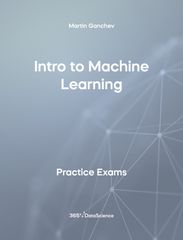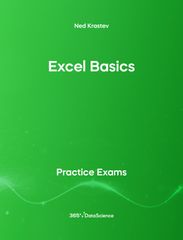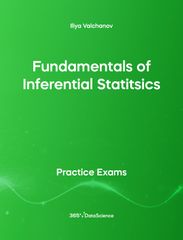365 Data Science Resources Center
Discover over 277 free data science resources to simplify your learning journey. Enhance your data and AI training with comprehensive study materials, career guidance, and expert advice.Course Notes
All Course NotesCourse notes are the perfect complementary online data science study materials. They help you grasp fundamental concepts, refresh your memory when preparing for exams, and get a taste of our learning style.
Committed to your career success and development, we at 365 Data Science support you throughout your learning journey with free resources designed to enhance and guide your education. Our rich selection covers everything from data science notes for beginners to simplified explanations of advanced topics. Choose a subject you wish to master, download our free PDF course notes, and start learning.

Intro to AI Course Notes
Our Intro to AI Course Notes provides a thorough overview of artificial intelligence fundamentals to help you master foundational concepts and get started with advanced techniques. These notes are an essential part of our Intro to AI course and cover a wide range of topics—from machine learning basics to deep learning and AI techniques—offering a solid foundation for anyone interested in AI. Key topics discussed: AI Fundamentals: Natural vs Artificial Intelligence, history, and critical concepts Data in AI: The role of structured and unstructured data and data collection methods AI Techniques: Machine learning (supervised, unsupervised, reinforcement) and deep learning AI Branches: Robotics, computer vision, and generative AI Generative AI and NLP: Development of language models and advancements in NLP These AI lecture notes are a valuable resource for students and professionals that will help you understand the intricacies of artificial intelligence and prepare you for various AI job roles. If you wish to explore AI and understand what it takes to succeed in this rapidly evolving field, download our Intro to AI Course Notes for a comprehensive guide.
Learn More
SQL DELETE Statement Notes
Our SQL DELETE Statement notes provide a comprehensive guide to the SQL DELETE Statement—essential for removing unwanted data from your databases. What is the SQL DELETE Statement? The SQL DELETE statement is a fundamental SQL command that deletes existing records in a database. These notes explain the syntax needed to write effective DELETE SQL queries. You’ll learn about the DELETE FROM WHERE conditions command, which allows you to specify the exact SQL rows to delete. Understanding how to delete a row in SQL is crucial for maintaining clean and efficient databases. One of the critical aspects covered in these notes is the ON DELETE CASCADE option, which is part of the foreign key constraint. This option ensures that if a specific value from the parent table’s primary key is deleted, all corresponding records in the child table will also be removed. This feature is essential for maintaining referential integrity within your database. The notes also compare the SQL DELETE command with other SQL commands for removing data, such as TRUNCATE and DROP. The section on TRUNCATE vs DELETE highlights the differences in performance and usage scenarios between these two commands. The DROP vs TRUNCATE vs DELETE section also provides insights into when to use each command for optimal database management.
Learn More
SQL UPDATE Statement Notes
Our SQL UPDATE Statement notes offer a comprehensive guide to the SQL UPDATE Statement—essential for modifying existing data in your databases. What is the SQL UPDATE Statement? The SQL UPDATE is a crucial SQL command used to modify existing records in a database. These notes provide detailed information on the syntax needed to write effective SQL UPDATE statements. You learn about the UPDATE table_name SET column_1 = value_1 command, which allows you to update specific columns, and the SQL WHERE condition, which ensures you only update the desired records. Additionally, this guide covers SQL best practices for handling database updates to provide accurate and efficient data management. You can execute precise and controlled updates by mastering the SQL UPDATE syntax and understanding the use of TCL commands. The notes explore the TCL COMMIT and TCL ROLLBACK commands—essential for managing transactions in SQL. The COMMIT statement saves the transaction in the database, while the ROLLBACK clause allows you to revert to the last committed state, ensuring your data remains consistent and accurate.
Learn More
SQL Insert Statement Notes
Our SQL INSERT Statement Notes offer a comprehensive guide to the SQL INSERT Statement—essential for adding new data to your databases. What is the SQL INSERT Statement? The SQL INSERT statement is a vital SQL command to add new records to a database. This resource provides detailed information on the syntax needed to write effective INSERT statements. You can learn how to update your database and add new information, including the INSERT INTO statement—allowing you to add data to specific columns—and the INSERT INTO SELECT command, which facilitates inserting data from one table into another. Download these SQL INSERT Statement notes to thoroughly understand one of SQL's most essential commands. With this resource, you'll confidently manage and add data to databases—ensuring your data management practices are efficient and effective.
Learn MoreTemplates
All TemplatesAccelerate your workflow with code-ready data science templates from 365 Data Science instructors—designed to enhance efficiency in your programming projects.
Discover a myriad of valuable resources—from a time-saving data science cheat sheet to data analysis and visualization templates in Excel and ready-to-use SQL, R, and Python coding shortcuts.
Whether you’re unsure how to approach a task or work on a time-sensitive project, these templates are designed to streamline your work and enhance productivity.
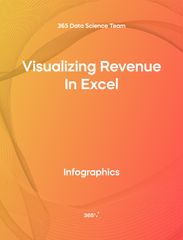
15 Ways to Visualize Revenue
Our Excel revenue visualization template offers a comprehensive array of data visualization examples—perfect for understanding your data more intuitively. What is the Excel revenue visualization template? This template is an expansive tool for visualizing revenue data in Excel—providing 15 different visualization methods and examples tailored to diverse analytical needs and presentation styles. It includes all kinds of revenue graphs—from straightforward column and pie charts to more complex data visualization methods like waterfall and Pareto charts. Each revenue chart provides a unique perspective on data, making it a versatile tool for data science students, researchers, and enthusiasts needing to present or understand complex data comprehensively. Simply input your data into any of the following revenue charts to visualize your revenue in Excel. Column chart: Revenue development over time Sparklines chart: Revenue development over time Treemap chart: Revenue by product over time Stacked area chart: Demonstrate the contribution of revenue components Clustered column chart: Show revenue split by category and over time Pie chart: Revenue breakdown in a single period Doughnut chart with total: Revenue breakdown in a single period with total Waterfall chart: Compare annual revenue in a year-over-year growth chart Scatter plot: Plot revenue vs marketing spend Bubble chart: Compare the number of products by company and revenue Combo chart: Track revenue development and margins over time Pie of Pie: Provide a macro and a micro breakdown Map chart: Geographical distribution of revenue Pareto chart: Cumulative revenue contribution by revenue category Funnel chart: Website conversion rate You can choose the ideal method to visualize and extract valuable insights from your data, such as revenue growth charts or breakdowns according to categories like location.
Learn More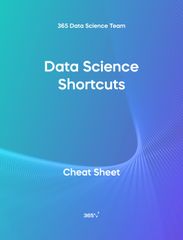
Data Science Shortcuts Cheat Sheet
Discover how to boost your productivity using this data science shortcuts cheat sheet with over 2,000 workarounds in Python IDEs, such as Jupyter, Spyder Rodeo, PyCharm, and Atom, compatible with various operating systems. Amplify your proficiency in R with R Studio shortcuts, streamline MATLAB operations, and manage databases efficiently with SQL shortcuts. Enhance data visualization in Tableau, easily manage Excel spreadsheets, and conduct statistical analyses seamlessly in SPSS and SAS. This data science shortcuts cheat sheet lets you speed up your everyday tasks while achieving your goals.
Learn More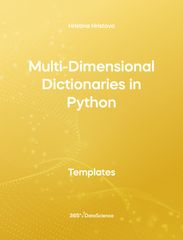
Multi-Dimensional Dictionaries in Python
The following is a program implementing a multi-dimensional dictionary in Python. The notebook shows how to retrieve keys and values from the dictionary, how to create a new key:value pair and how to loop through the keys and the values using a for-loop. Some other related topics you might be interested in are One-Dimensional Dictionaries in Python, Dictionary Comprehension in Python, Using Counter - a Dictionary Subclass in Python. The Multi-Dimensional Dictionaries in Python free template is among the topics covered in detail in the 365 Program.
Learn More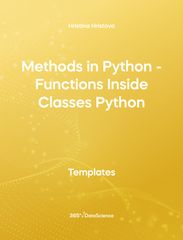
Methods in Python - Functions Inside Classes in Python
In Python, we can design and create our own objects with the help of classes. In this free notebook, we will design a class and define two functions inside - two methods. In Python, methods are accessed through the dot-notation. They help interact with an object and are an essential part of a class. Some other related topics you might be interested in are Defining classes in Python, The Pass-Statement in Python, Creating a Constructor in Python - the INIT method, Class Variables in Python, Inheritance in Python. The Methods in Python – Functions Inside Classes in Python template is among the topics covered in detail in the 365 Program.
Learn MoreInfographics
All InfographicsNavigate your way through the sea of weighty data and AI content with the help of our 365 Data Science infographics. Simplify and enhance your learning experience through memorable visual representations—available to download for free.
Explore a treasure trove of resources:
- Data science infographics for field navigation
- AI infographics for simplifying complex topics
- ChatGPT infographics with prompts
- Data analytics infographics for role guidance
These visuals are designed to make complex information easily understandable, enhancing your learning experience.

What Is the Central Limit Theorem? Infographic
The Central Limit Theorem (CLT) is a fundamental concept in statistics. But what exactly is the Central Limit Theorem? The Central Limit Theorem definition states that the distribution of sample means approximates a normal distribution as the sample size increases, regardless of the underlying population distribution. Understanding what the Central Limit Theorem says is crucial for statistical inference and probability theory. If you want to develop a deeper understanding of this concept, this Central Limit Theorem infographic provides a comprehensive overview of CLT in statistics, including its definition and why it matters. This resource also explains when to use the Central Limit Theorem and demonstrates how it works in real-world scenarios. It also addresses important considerations about Central Limit Theorem sample size requirements and helps clarify common misconceptions about normal distributions. Download our free Central Limit Theorem infographic to get an easy-to-reference guide that breaks down this essential statistical concept into clear, understandable components.
Learn More
World of Open-Source Generative AI Infographic
The rise of artificial intelligence and its generative capabilities have transformed how we develop, deploy, and interact with AI solutions. Our World of Open-source Generative AI infographic provides a comprehensive overview of critical open-source AI tools and resources shaping the future of AI. From foundational models to orchestration tools, this visually appealing infographic details the open-source generative AI landscape—highlighting the advantages and considerations for each category. In this free downloadable AI infographic, you’ll explore the following elements critical to open-source generative AI. Foundation Models: Understand the role of large, pre-trained models like LLaMA and GPT-2 and how they’re used as bases for further adaptation. Datasets: Learn about open-source datasets crucial for training and validating AI models. Vector Databases: Discover how these databases facilitate quick and scalable similarity searches. Orchestration Tools: See how tools streamline the construction of LLM-powered applications. Evaluation Tools: Assess AI model performance and reliability with cost-effective solutions like DeepEval, deepchecks, arize, and Langdock. Community and Ethics: Engage with the vibrant AI community and understand the ethical frameworks guiding open-source AI development.
Learn More
Gradient Descent Infographic
Our Gradient Descent Infographic provides an in-depth overview of an essential method widely applied in machine learning. What is Gradient Descent? Gradient Descent is an optimization algorithm that finds the local minimum of a function. It’s used in machine learning for cost function minimization. Gradient descent is essential to various machine learning models used by data scientists and machine and deep learning engineers. The infographic offers a well-rounded definition of gradient descent, machine learning applications, and the method's intuition. It further outlines the step-by-step process of the gradient descent algorithm—starting with initial coefficient values and repeating the process until converging on a minimum. The infographic also highlights the gradient descent assumptions and compares the pros and cons of stochastic gradient descent—a variant that updates the coefficients more frequently.
Learn More
Regularization Infographic
Our regularization infographic provides a comprehensive overview of an essential machine-learning technique. Regularization is a technique that helps prevent models from overfitting by introducing constraints into the loss function. For instance, in logistic regression, regularization techniques can be used to optimize the model's performance. The infographic provides a clear, concise definition of regularization, highlighting its role in balancing overfitting and underfitting. It illustrates how adding noise and improving generalization enhance model performance on new data. It also gives in-depth look at various regularization methods, including L1 regularization (Lasso regularization) and L2 regularization (Ridge regularization). It explains their formulas and how they influence coefficient adjustment in model training. Additionally, the infographic explores Elastic Net, a method blending Ridge and Lasso regularization, along with a 2-stage regularization process.
Learn MoreCareer Guides
All Career GuidesSave yourself hours of browsing the internet and reading fragmented, outdated information. Our meticulously curated data and AI career guides assist you at every stage of your journey, providing the knowledge, support, and expert advice to find a job that aligns with your needs and interests.
We thoroughly research the in-demand skills, required qualifications, job outlook, and career progression opportunities in data and AI. Whether you want to pursue a career as a data analyst, data scientist, or AI professional, you’ll find the necessary job guides and resources to kickstart your journey. Leverage our free PDF career guides as your roadmap to designing your professional development.

AI Interview Guide
Set yourself up for success in artificial intelligence with our AI Interview Guide—a comprehensive collection of AI interview questions to help you excel and land your dream role. This guide is tailored for aspiring and experienced AI professionals and provides everything you need to prepare for the most demanding AI interview scenarios. What’s Inside? Comprehensive Question Sets: Gain access to a curated list of AI interview questions and answers—ranging from general artificial intelligence questions to specialized topics like generative AI, NLP, and computer vision interview questions. Role-Specific Guidance: Whether you’re preparing for such roles as AI Engineer, AI Project Manager, or AI Research Scientist, this guide is packed with questions and insights relevant to your career aspirations. Practical Advice and Real-World Examples: Learn how to confidently respond to challenging questions and showcase your expertise via practical examples and actionable tips. Interview Preparation Essentials: From foundational questions about AI to advanced problem-solving scenarios, this guide ensures you’re fully prepared for technical and behavioral interview stages. Download the guide and take the next step toward securing your place in the dynamic and rewarding world of artificial intelligence.
Learn More
Machine Learning Engineer Career Guide 2024
Discover your pathway to becoming a machine learning engineer with our comprehensive career guide—designed to equip you with the essential knowledge and skills needed to land your dream job in this field. This guide provides an in-depth overview of the machine learning engineer career—detailing everything from the key roles and responsibilities to the essential skills and qualifications required. Here’s what’s included: Discover what machine learning engineers do daily, which can help you determine if this is the right career for you. Gain insights into the current ML engineer job market, learn about various career paths, and understand the educational and professional milestones needed to excel. Learn the machine learning engineer requirements and discover how to create an impressive portfolio with this comprehensive guide. Receive practical advice on: Crafting a standout resume Preparing for machine learning engineer interviews Effectively networking to enhance your job prospects With sections dedicated to beginners and experienced professionals, our guide ensures you have all the resources needed to pursue a successful machine learning career path. Download this machine learning engineer career guide now to discover how you can shape your future in one of the most promising careers in the tech industry.
Learn More
Machine Learning Engineer Cover Letter Template
Our machine learning engineer cover letter template provides a structured and effective way to showcase your qualifications for roles in machine learning and artificial intelligence. Designed for clarity and impact, this template highlights your experience, skills, and achievements—ensuring your cover letter stands out. It includes a professional introduction, detailed sections to outline your relevant expertise, and a strong closing statement that conveys your enthusiasm for the role. With this machine learning engineer cover letter, you can confidently apply to any position, presenting yourself as a well-qualified candidate ready to make an impact. Download this cover letter template for free to boost your job-search this year.
Learn More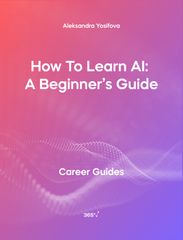
How to Learn AI. A Beginner's Guide
Recent technological developments have spurred both excitement about the world of opportunities and fear of becoming obsolete. While the adoption of artificial intelligence has led to the automation of many tasks, new roles continue to emerge daily. Upskilling is the only way to stay current in this AI-driven world, and those who know how to adapt and leverage new technologies will thrive in the future job market. Our comprehensive How to Learn AI guide helps you navigate the dynamic work environment by introducing you to a future-proof strategy for getting started with AI.
Learn MorePractice Exams
All Practice ExamsDiscover a plethora of online exams that will test your current knowledge and ability to solve data science problems. Evaluate your skills online at no cost with SQL mock tests, Excel and NumPy exam questions, and more.
Whether you’re studying for an exam, preparing for an interview, or looking to check your knowledge level, our data science practice exams will ensure you’re up to the task. Timed to simulate a real-life experience, the data science test questions verify your theoretical understanding and technical skills.
Identify areas for improvement to enhance your skills, critical thinking, and problem-solving abilities—bringing you closer to achieving your goals.
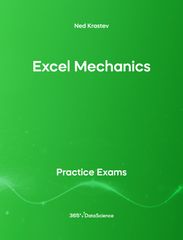
Excel Mechanics
Imagine if you had to apply the same Excel formatting adjustment to both Sheet 1 and Sheet 2 (i.e., adjust font, adjust fill color of the sheets, add a couple of empty rows here and there) which contain thousands of rows. That would cost an unjustifiable amount of time. That is where advanced Excel skills come in handy as they optimize your data cleaning, formatting and analysis process and shortcut your way to a job well-done. Therefore, asses your Excel data manipulation skills with this free practice exam.
Learn More
Formatting Excel Spreadsheets
Did you know that more than 1 in 8 people on the planet uses Excel and that Office users typically spend a third of their time in Excel. But how many of them use the popular spreadsheet tool efficiently? Find out where you stand in your Excel skills with this free practice exam where you are a first-year investment banking analyst at one of the top-tier banks in the world. The dynamic nature of your position will test your skills in quick Excel formatting and various Excel shortcuts
Learn More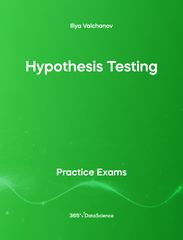
Hypothesis Testing
Whenever we need to verify the results of a test or experiment we turn to hypothesis testing. In this free practice exam you are a data analyst at an electric car manufacturer, selling vehicles in the US and Canada. Currently the company offers two car models – Apollo and SpeedX. You will need to download a free Excel file containing the car sales of the two models over the last 3 years in order find out interesting insights and test your skills in hypothesis testing.
Learn More
Confidence Intervals
Confidence Intervals refers to the probability of a population parameter falling between a range of certain values. In this free practice exam, you lead the research team at a portfolio management company with over $50 billion dollars in total assets under management. You are asked to compare the performance of 3 funds with similar investment strategies and are given a table with the return of the three portfolios over the last 3 years. You will have to use the data to answer questions that will test your knowledge in confidence intervals.
Learn More
